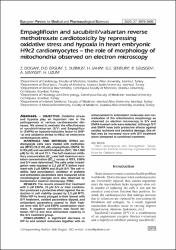Empagliflozin and sacubitril/valsartan reverse methotrexate cardiotoxicity by repressing oxidative stress and hypoxia in heart embryonic H9c2 cardiomyocytes - the role of morphology of mitochondria observed on electron microscopy

Göster/
Erişim
info:eu-repo/semantics/openAccessTarih
2023Yazar
Doğan, ZekiErgun, D. D.
Durmus, S.
Şahin, Hilal
Şentürk, G. E.
Gelişgen, Remise
Senyigit, A.
Uzun, Hafize
Üst veri
Tüm öğe kaydını gösterKünye
Dogan, Z., Ergun, D. D., Durmus, S., Sahin, H., Senturk, G. E., Gelisgen, R., Senyigit, A., & Uzun, H. (2023). Empagliflozin and sacubitril/valsartan reverse methotrexate cardiotoxicity by repressing oxidative stress and hypoxia in heart embryonic H9c2 cardiomyocytes - the role of morphology of mitochondria observed on electron microscopy. European review for medical and pharmacological sciences, 27(9), 3979–3992. https://doi.org/10.26355/eurrev_202305_32304Özet
Objective: Oxidative stress and hypoxia play an important role in the pathogenesis of various cardiovascular diseases. We aimed to evaluate the effectiveness of sacubitril/valsartan (S/V) and Empagliflozin (EMPA) on hypoxia-inducible factor-1α (HIF-1α) and oxidative stress in H9c2 rat embryonic cardiomyocyte cells. Materials and methods: BH9c2 cardiomyocyte cells were treated with methotrexate (MTX) (10-0.156 μM), empagliflozin (EMPA; 10-0.153 µM) and sacubitril/valsartan (S/V; 100-1.062 µM) for 24, 48 and 72 h. The half maximum inhibitory concentration (IC50) and half maximum excitation concentration (EC50) values of MTX, EMPA and S/V were determined. The cells under investigation were exposed to 2.2 μM MTX before treatment with 2 μM EMPA and 25 μM S/V. The cell viability, lipid peroxidation, oxidation of proteins and antioxidant parameters were measured while morphological changes were also observed by transmission electron microscopy (TEM). Results: The results showed that treatment with 2 µM EMPA, 25 µM S/V or their combination produced a protective effect against the reduction in cell viability caused by 2.2 µM MTX. While HIF-1α levels plunged to their lowest with S/V treatment, oxidant parameters dipped, and antioxidant parameters soared to their highest level with S/V and EMPA combination treatment. A negative correlation was found between HIF-1α and total antioxidant capacity in the S/V treatment group. Conclusions: A significant decrease in HIF-1α and oxidant molecules together with an enhancement in antioxidant molecules and normalization of the mitochondria morphology as observed on electron microscopy in S/V and EMPA-treated cells were detected. Although S/V and EMPA have both protective effects against cardiac ischemia and oxidative damage, this effect may be increased more with S/V treatment alone compared to combined treatment.
















